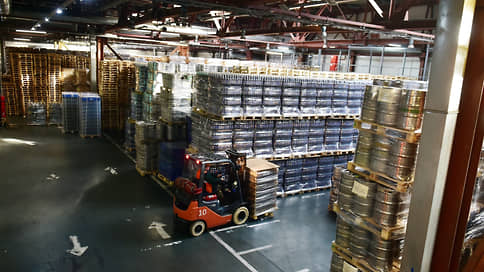Beer imports to Russia at the end of 2023 failed to reach pre-crisis levels
[ad_1]

Beer supplies in Russia, which began to recover in the first months of 2023, were unable to reach pre-crisis levels. Over the past year, import volumes increased by 12.6%, to 370.5 million liters, which is less than in 2020-2021. Market participants attribute the result to the devaluation of the ruble in the second half of 2023, which affected the cost of inexpensive imported beer, difficulties with logistics and the expansion of the range of local brands.
The volume of beer imports to Russia at the end of 2023 increased year-on-year by 12.6%, to 370.5 million liters, but remained below the levels of 2020–2021, as follows from data available to Kommersant from market participants. In 2020, according to these figures, 397 million liters of beer were imported into Russia, in 2021 – 457 million liters.
769.6 million deciliters
of beer sold at retail in Russia in 2023, according to Rosalkogoltabakcontrol.
Beer imports to Russia began to decline in 2022 after the outbreak of hostilities in Ukraine, when companies from the UK, USA and Canada stopped supplies. And, although imports were actively recovering in the first months of 2023, then the pace slowed down. Based on the results of January-June 2023, the volume of beer imports grew year-on-year by 34.9%, to 179.9 million liters, and imports in the second half of the year – 190.6 million liters – were 2.4% less than a year earlier. .
The founder of the “Taking a Day Off” chain, Nikolai Zhelagin, says that in the first months of 2023, retail chains were actively making up for the shortage of imported beer. At that time, unknown stamps issued in Europe could be sold for 50–70 rubles. for 0.5 liters, also competing with some local brands, he says. But due to the devaluation of the ruble, the competitiveness of inexpensive imports has decreased, Mr. Zhelagin points out. Igor Khavsky, co-owner of the distributor SWAM Group and the Gletcher brewery, notes that supplies continue to be affected by the reluctance of some manufacturers to work with companies from the Russian Federation and logistics difficulties that worsened at the end of last year, including queues at the border.
About 44% of beer imports in 2023, according to data available to Kommersant, were provided by Krasnoe&Beloye, Bristol and X5 Group (Pyaterochka, Perekrestok). X5 reported that its own beer imports in 2023 increased by a “moderate” 14% year-on-year in 2023 due to the partial replacement of foreign brands with local ones. In 2024, X5 plans to expand the geography of supplies and replenish the range. According to NielsenIQ, in 2023, the average number of items (SKU) of imported beer on store shelves decreased from 12 to 10 SKU, while local beer increased from 58 to 63 SKU. The share of imported beer in volume sales year-on-year, according to NielsenIQ, increased from 3.7% to 3.8%. Krasnoe&Beloe did not provide a comment.
According to data available to Kommersant, more than 51.7% of beer imports in 2023 came from drinks from Germany; year-on-year imports increased by 14%, to 197.1 million liters.
Among the most supplied brands are Feldschlosschen, Furstkeg (brand X5) and Eurotour. Imports from the Czech Republic in 2023 increased by 49%, to 49 million liters (brands Prazacka, Cernovar, etc.), from Belgium – by 36.4%, to 37.8 million liters (Belgian Krone, Willianbrau). And beer supplies from Mexico (Corona) and China (Harbin, Tsingtao) increased by 72.6% and 84.4%, to 22.1 million liters and 21.4 million liters, respectively.
Executive Director of the Association of Beer, Malt and Beverage Producers (APP; includes AB InBev Efes, Baltika, United Breweries) Vyacheslav Mamontov says that the business of Russian brewers is negatively affected by the parallel import of beer without the permission of the copyright holder, including brands produced in the Russian Federation or replaced by analogues. The United Breweries (Krusovice, Bochkarev) noted that the excess brewing capacity in Russia can fully satisfy demand.
According to Nikolai Zhelagin, some consumers could find an alternative to imported beer among local brands from 2022, if we are not talking about specialized varieties. In his opinion, without a significant strengthening of the ruble, restoring import volumes to the 2021 level is hardly possible. In addition, Mr. Zhelagin points out, there is currently no marketing support for foreign manufacturers.
Igor Khavsky notes that simplifying the procedure for labeling imported beer could make business easier for distributors, which the Ministry of Finance requested from Opora Rossii. In the letter (Kommersant has a copy), the organization asks to allow labeling of imported beer at the importer’s warehouse in the Russian Federation in the conditional release mode of goods upon provision of a report on the application of the codes stated in the import declaration. This will reduce costs for the services of warehouse operators in the Baltics, the letter states. The Ministry of Finance told Kommersant that the issue is being studied. The operator of the labeling system, TsRPT, says that 46 warehouses providing the service in the Russian Federation and other countries with a double supply cover the needs of the beer industry. The Ministry of Industry and Trade added that the movement of unmarked products threatens to increase the share of illegal trafficking.
[ad_2]
Source link





